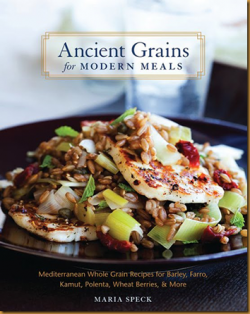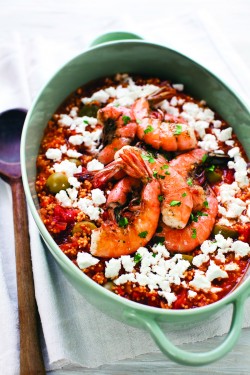As the celebration continues in honor of Whole Grains Month we thought it would be a wonderful time to have a Q&A with a great friend of Oldways and the Whole Grains Council who also happens to have a long time love affair with whole grains. Our friend Maria Speck is a food journalist and author, who has created quite a name for herself in the Whole Grains World, with the New York Times naming her book, “Ancient Grains for Modern Meals,” one of the best cookbooks of the summer!
Oldways: You say in your book that “the glamorous qualities of whole grains are vastly underrated.” Can you tell us about some of those “glamorous qualities?”
Maria: I love this question! Many people think of whole-grains as bland, or even “blah.” This, of course, is not true at all. I believe whole grains bring amazing flavors, rich textures and even stunning colors to our tables. Think of the buttery aroma of bronze Kamut berries, the slight tang of rye, or Chinese black rice which turns a marvelous burgundy when cooked. I consider these star qualities, and I want to showcase whole grains in their glorious beauty at the center of our meals.
Oldways: You characterize whole grain baked goods as having a “distinct texture and appealing chew” and to you, this is a definite plus. Have you always preferred the fuller, nuttier taste of whole grains, or have your tastes changed over your lifetime? When did your passion for whole grains begin?
Maria: I was very lucky. I was raised in Greece and Germany, and in both cultures whole grains with their distinct textures and aromas are still part of the culinary fabric. They were simply on our table as part of everyday meals, such as bulgur in Greece or a textured loaf of bread in Germany. I was never told to eat whole grains because they are “oh so good” for me. I believe we have done whole grains a disservice by calling them “healthy” instead of presenting them for what they are: delicious. And if you don’t want to chew much, relax. So many whole grains are pure comfort food, such as whole wheat couscous, millet, or cornmeal. Whole grains are for everyone.
Oldways: For those who may not have much experience with whole grains, is there a particular grain that you would suggest they start with?
Maria: Trendy quinoa, a delicate grain with its tiny translucent pearls, is a great one to start. It has an appealing mild and sweet grassy flavor, cooks up in only about 15 minutes, and works beautiful in salads and sides. Furthermore, quinoa is a high-quality protein and gluten-free. Another favorite of mine is fiber-rich bulgur, some call it ancient fast food. Bulgur has a fantastic nutty aroma, it is versatile, and cooks fast—perfect for busy weeknights.
Oldways: We know you love whole grains, but do you have one variety that you particularly treasure? why?
Maria: Golden millet is a dinner favorite, especially in the cooler months of the year. I really hope people try this versatile grain, a staple in Africa and India. It has an appealing mildness, and can be made into sweet desserts, or a savory side or main dish—it has the comforting feel of a polenta. What’s not to like?
Oldways: It’s interesting to learn that you got hooked on whole grains because of their taste, then were surprised and delighted at how they have helped you maintain a healthy weight. Can you tell us more about how this came about?
Maria: Just like so many of us, I was constantly dieting as a young woman. And I was really bad at it because I love good food. As a kid in Greece, I enjoyed bulgur and wheat berries, but when I started to work as a young journalist in Germany, I had forgotten about these delicious staples. I was on a diet of frozen pizza and store-bought chocolate pudding! Then one day my neighbor put a beautiful wheat berry salad with farmer’s market vegetables and fresh cheese in front of me. This brought so many memories back, and it made me curious about the textures and flavors of whole grains, so I started cooking. And, of course, we all know that whole grains are very nutritious and keep you full longer. So suddenly I enjoyed all good food, with whole grains as the center of my meals—dieting became history, and I never went hungry again. What could be better!
Oldways: We could not walk away from this chat without asking, is there a recipe from the book you could share with our readers?
Maria: Yes, I would love to share the Greek Millet Saganaki with Shrimp and Ouzo to introduce people to the fabulous versatility of millet. A saganaki is a traditional two-handled skillet in which Greeks cook aromatic one-pot dishes, typically topped with cheese. In my version of the classic shrimp saganaki, the shrimp are placed on a bed of juicy tomato-infused millet that is sprinkled with feta—it resembles Southern shrimp and grits. This combination has instant appeal and is a great introduction to this underappreciated grain. And in my house it has converted even the die-hards.
Greek Millet Saganaki with Shrimp and Ouzo
Millet
1¼ cups water
¾ cup millet
1 bay leaf
Pinch of fine sea salt
Saganaki
1 tablespoon extra-virgin olive oil
1 cup finely chopped yellow onion (about 1 small)
1 clove garlic, peeled and slightly crushed
1 small hot green chile, minced (optional)
¼ teaspoon fine sea salt
2 tablespoons tomato paste
1 (28-ounce) can whole tomatoes, crushed in a bowl
¼ teaspoon freshly ground black pepper
½ cup green pimiento-stuffed olives, halved if large
4 ounces coarsely crumbled Greek feta cheese (about 1 cup), preferably sheep’s milk
shrimp, and to finish
1 pound jumbo shell-on shrimp, deveined and patted dry
Fine sea salt and freshly ground black pepper
2 tablespoons extra-virgin olive oil
⅓ cup ouzo, or other anise-flavored liqueur
¼ cup chopped fresh flat-leaf parsley
1. To prepare the millet, bring the water, millet, bay leaf, and salt to a boil in a 2-quart saucepan. Decrease the heat to maintain a simmer, cover, and cook until the water is absorbed, about 15 minutes. Remove from the heat and let sit, covered, for 5 to 10 minutes. Uncover, remove the bay leaf, and set aside to cool.
2. Meanwhile, make the saganaki. Heat the olive oil in a large Dutch oven or large heavy-bottomed saucepan over medium heat until it shimmers. Add the onion, garlic, chile, and salt; cook, stirring frequently, until the onion softens and turns light golden, about 5 minutes. Add the tomato paste and cook, stirring, until it darkens, about 1 minute. Add the tomatoes with their juices and the pepper; bring to a boil over medium-high heat. Decrease the heat to maintain a light boil and cook, uncovered, for 3 minutes.
3. Stir in the millet and green olives. Taste for salt and pepper and adjust (keeping in mind that olives and feta cheese can be quite salty). Remove the pot from the heat, sprinkle with the feta, and cover to allow the cheese to soften.
4. To prepare the shrimp, season them with salt and pepper. Heat the olive oil in a 12-inch skillet over high heat until it shimmers. Add the shrimp. Cook, undisturbed, until the shrimp turn golden, 1 to 2 minutes, and then flip them with a spatula and cook until they are just opaque throughout, 1 to 2 more minutes, depending on the size. Add the ouzo and cook until syrupy, about 30 seconds. Using a spatula, briskly remove the shrimp from the pan and arrange on top of the millet. Sprinkle with the parsley and serve at once.









Leave a comment